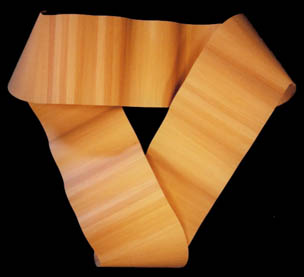|
Moebius Mistake When asked whether I ever make mistakes in the construction of my sculptures there is always the obvious answer: of course. But actually, sometimes it depends on how you look at it. For instance, Moebius Trip had been on my to-do list for several years, but it always seemed that it would be too difficult, if not impossible, given the constraints I had given myself: in line with my other hemlock sculptures, I wanted to construct a Moebius strip by gluing together many identical copies of a single unit shape. Because of the form of the particular Moebius strip that I held in my mind (the piece of paper with a half twist that we all encountered in school), it seemed impossible to make such a Moebius strip without using many different wood pieces each with slightly varying angles.
That evening I began fooling around with another simple Moebius form that has always intrigued me. This one is made from a thin strip laid on a table and folded one side at a time into an equilateral triangular outline. This looked like a promising shape, as the folded corners could be replaced with the cones suggested by Roger's model. Next day Roger appeared with another model, more elegant and tempting than his first and somewhat resembling a treble clef symbol. The only problem I could see was that a wooden version of this paper model wouldn't be stable enough. Roger liked my simple folded and taped strip, particularly because it pointed out that there appears to be essentially two basic (though essentially trivially different) forms of the Moebius strip. After many demonstrations, he finally convinced me that the corners could each be constructed from two quarter cones, and I could then see that it would be possible to make the whole thing using only one basic shape (along with its mirror image). The two mirror-image shapes result from one bevelled diagonal cut through a cuboid (a sort of three-dimensional rectangle like a Kleenex box). Roger went home and I started the lengthy calculation phase. The first problem was to determine the shape of the corner cones, more accurately the angle of the cone's apex. After a few attempts to accurately draw the three-dimensional shape, and anxious to see the form realized, I gave up and resorted to a guestimate: it seemed reasonable that the cones would have a 60° apex, and so I proceeded as if it were a fact, reasoning that if I was wrong I could always make something else out of the pieces.
I took two taped quarter cones over to Roger's house for his opinion. They were accurate enough to serve as models of what they should be and, from them, Roger drew two-dimensional diagrams of the three-dimensional problem. He later calculated the cone's correct angle to be 54.36806°. Based on an idealized complete cone with that apex angle and standing 30 cm high, 40 isosceles triangular pieces could be assembled into a polyhedron that resembled the idealized cone. Each piece would be 34.72156 cm long and 2.5 cm wide at the base, with both long edges having 4.00457° bevels. After a great deal of sanding the assembled polyhedron would look conical. Now, it's fine to have accuracies to the closest 100,000th of a degree, but some practical woodworking concerns were to make things more approximate. For instance, rather than trying to cut a large amount of identical isosceles triangular wedges (with 4.00457° bevels on each long side), it was much easier to start with long cuboids and divide them in two, resulting in right angled wedges. After tilting the blade 8.00914° off vertical - twice the earlier angle (which, because of the nature of the tablesaw's blade bevel adjustment mechanism, could indeed be set very accurately) - each piece was cut in two on the diagonal, resulting in mirror-image, wedge-shaped pieces, with one side cut at 81.99086° and the other cut at 90°. It would have made the theoretical solid geometry problem much more tedious to calculate using these right angled shapes, and it wasn't initially obvious that it would make any difference anyway. After watching Roger diagram the problem and seeing how he calculated the angles, I went home and decided to redo the calculation. It took a while to get it, but eventually I came to the same result as Roger. I called to thank him and tell him that my calculations agreed with his, but was told that he thought there was an error. He had also redone the calculations and come up with a slightly different answer, but unfortunately he was going away for two weeks and couldn't work on it until getting back.
As soon as Wave Length had been assembled, I went back to my calculations for the Mobius strip, trying it again all from scratch. I did it different ways and always came up with the same answers: a 54.36806° cone and pieces with two 4.00457° bevels. So, in spite of Roger's angle-error warning, I decided to go ahead and refine some aspects of the calculations that had been influenced by the simplification of using right-angled (instead of isosceles) triangles. When I had done all the calculating I could think of, and was satisfied that something good would probably come of it, I cut about 1000 pieces, enough to allow me to reject perhaps 75% of the pieces for blemishes, color differences, scratches, included bark, sap, cracks, warps or a tendency to warp, twists, uneven thicknesses, wild grain pattern, oblique grain pattern, soft wood, hard wood, nicked edges and miscut pieces, including ones set aside for test cutting.
In due time, Roger returned saying that the original numbers seemed to be right. We went over the calculations again and again trying to see how they could seem so correct while the cut pieces of wood could obviously be so wrong. In the end, we tried varying the quarter cones, so instead of the calculated 10 pieces each, we kept adding pieces until the two `quarter' cones together seemed to nearly turn an exact 60° corner. Eventually we discovered that 12 pieces for the top quarter cone and 13 for the bottom (allowing for the sloppiness of the taped joints) made a corner tolerably close to 60° with parallel top and bottom edges whose vertical edges were nearly perpendicular to the table. It was close enough to be worth a try. After taping together Moebius Trip's 243 pieces and trying to keep it supported (so as not to pop off the masking tape) it looked like it would work. The only problem was that an accurate assessment would only be possible after a substantial amount of gluing, after which it could be difficult to find something to do with mistakes. I decided to glue it up in three large pieces, each one with a straight run of undulating up and down curves attached to a corner section made of the approximately quarter cones. Then, when these one-third sections were all glued and it only remained to glue the last three joints I could instead tape them together and find out how far out of alignment the ends were. A bit late to deal with any errors, but still better than having those last joints glued. As it turned out, it was nearly perfect; with only a few touches of a hand plane to three of the end pieces, it was done. We never did figure out exactly why the calculations didn't agree better with the cut pieces of wood, but it was probably the sum total effect of some of the simplifying assumptions we made. For instance, because I used right angled pieces instead of isosceles, the corner `cones' don't have a single apex. As each piece is glued to its neighbor, the longest side of one triangle, the hypotenuse, is glued to the (minutely shorter) long leg of the neighboring right angle, causing each piece's apex to move slightly ahead of the last one. The wonder of it was that in the end the construction turned out almost exactly as planned. Thank you Roger.
|
|
|||||
| © copyright 2001 Elias Wakan |
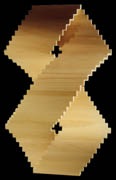
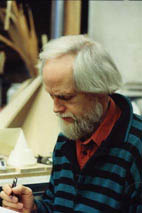 After calculating the number of pieces required (making sure to use a cone with enough pieces to be evenly divided by four) I allowed for 50% wastage. I selected and milled the lumber and used masking tape to get a quick approximate view of what a finished corner would look like. Unfortunately, there was no way it was going to work. Among other problems, the pieces cut for a 60° quarter cone didn't turn the required 60° corner for an equilateral triangle.
After calculating the number of pieces required (making sure to use a cone with enough pieces to be evenly divided by four) I allowed for 50% wastage. I selected and milled the lumber and used masking tape to get a quick approximate view of what a finished corner would look like. Unfortunately, there was no way it was going to work. Among other problems, the pieces cut for a 60° quarter cone didn't turn the required 60° corner for an equilateral triangle.
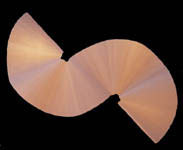 While thinking about the calculations I decided to try to find an interesting shape to assemble from the pieces cut for the original guestimated 60° cone solution. I found about five promising candidates and the one I chose became
Wave Length, almost a meter long and three quarters of a meter high and made from 90 pieces.
While thinking about the calculations I decided to try to find an interesting shape to assemble from the pieces cut for the original guestimated 60° cone solution. I found about five promising candidates and the one I chose became
Wave Length, almost a meter long and three quarters of a meter high and made from 90 pieces.
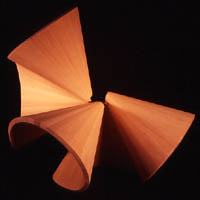 Once again, I rushed to tape the pieces together to see if it would work, and once again something was wrong. The corners seemed to be more or less 60°, but the top piece of the top quarter cone was not parallel to the bottom piece of the bottom quarter cone (nor was it perpendicular to the table) and so there would definitely be at least a mismatch with the straight sections on the sides. There was still almost a week before Roger returned so, before starting to cut a third pile of wood, I decided to look for yet another substitute sculpture to assemble from some of the pile of incorrectly cut pieces. This sculpture used 114 pieces and the end result is called Medici, in my opinion one of my most successful pieces ever.
Once again, I rushed to tape the pieces together to see if it would work, and once again something was wrong. The corners seemed to be more or less 60°, but the top piece of the top quarter cone was not parallel to the bottom piece of the bottom quarter cone (nor was it perpendicular to the table) and so there would definitely be at least a mismatch with the straight sections on the sides. There was still almost a week before Roger returned so, before starting to cut a third pile of wood, I decided to look for yet another substitute sculpture to assemble from some of the pile of incorrectly cut pieces. This sculpture used 114 pieces and the end result is called Medici, in my opinion one of my most successful pieces ever.
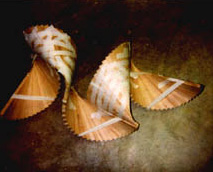 There are still enough servicable triangular pieces left over from Moebius Trip for two more constructions, which I will do next. I hope there are no more mistakes with these, but I'm not sure why: I'm as pleased with
Wave Length and Medici (the `mistakes' that led up to Moebius Trip) as I am with Moebius Trip itself. So, yes I do make mistakes, but I am lucky and grateful that, so far, many of them seem to end up with a beauty and correctness of their own.
There are still enough servicable triangular pieces left over from Moebius Trip for two more constructions, which I will do next. I hope there are no more mistakes with these, but I'm not sure why: I'm as pleased with
Wave Length and Medici (the `mistakes' that led up to Moebius Trip) as I am with Moebius Trip itself. So, yes I do make mistakes, but I am lucky and grateful that, so far, many of them seem to end up with a beauty and correctness of their own.
